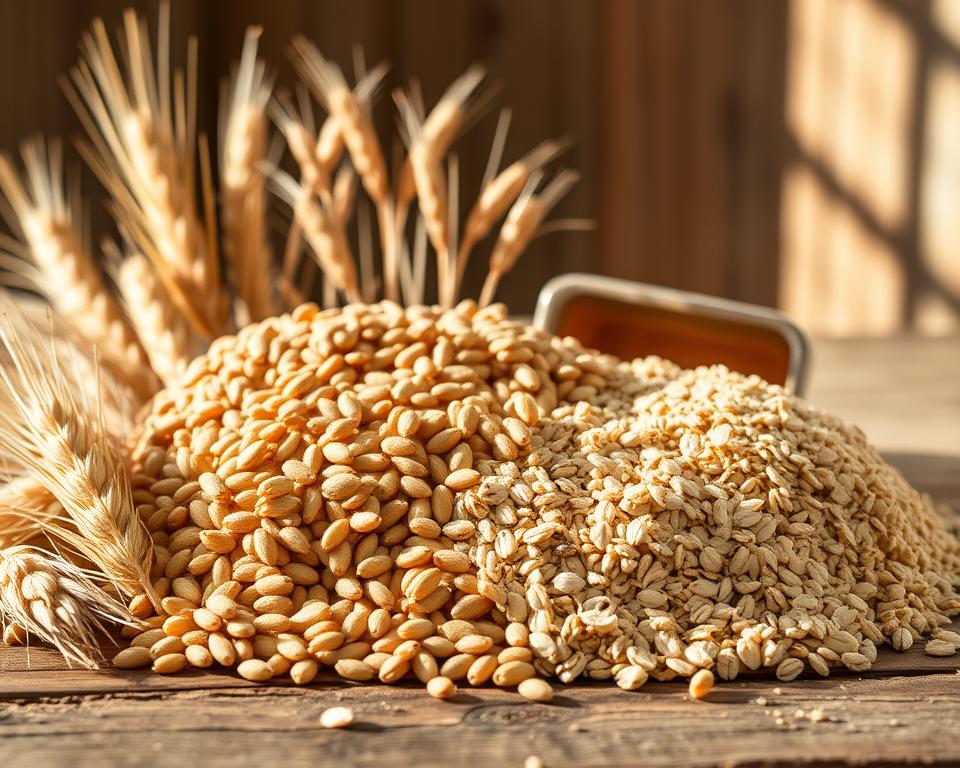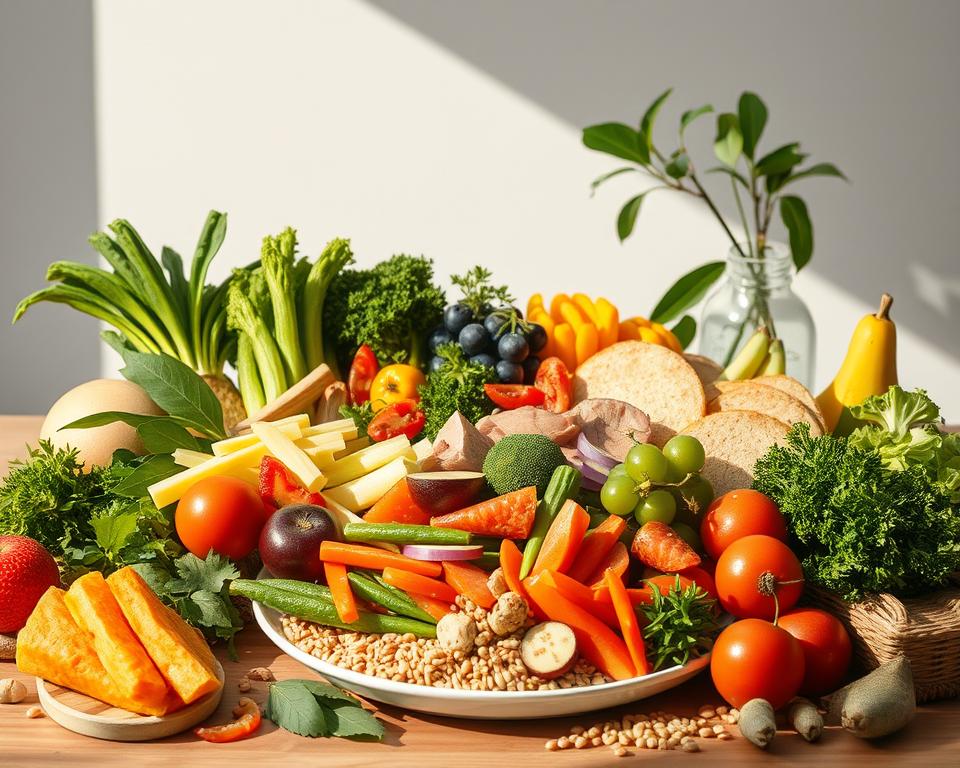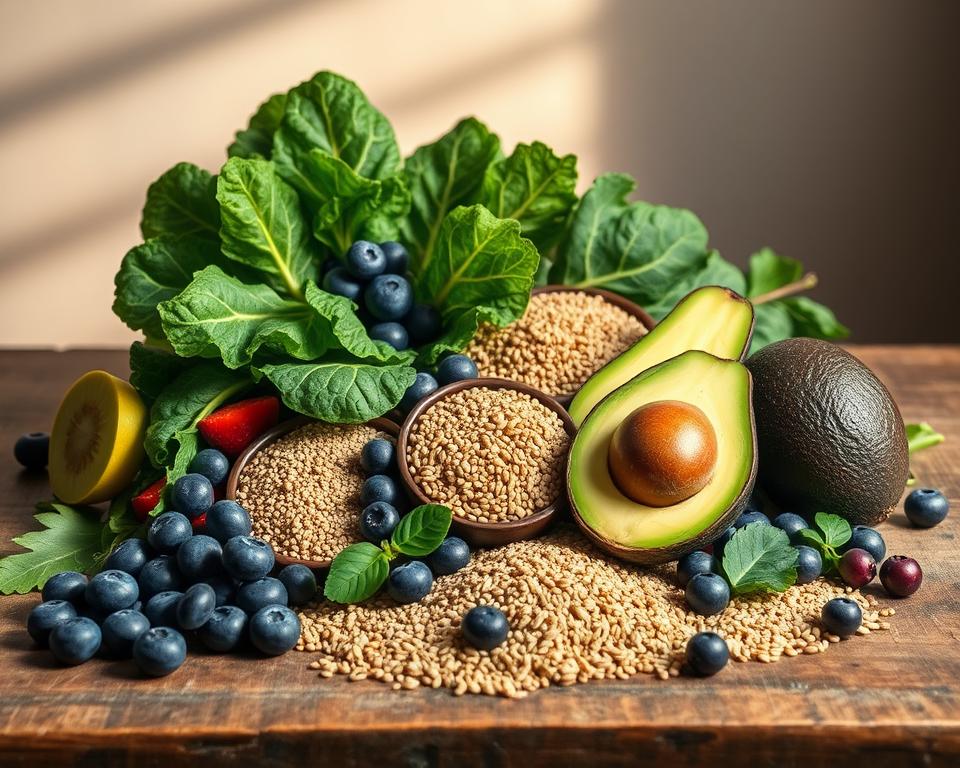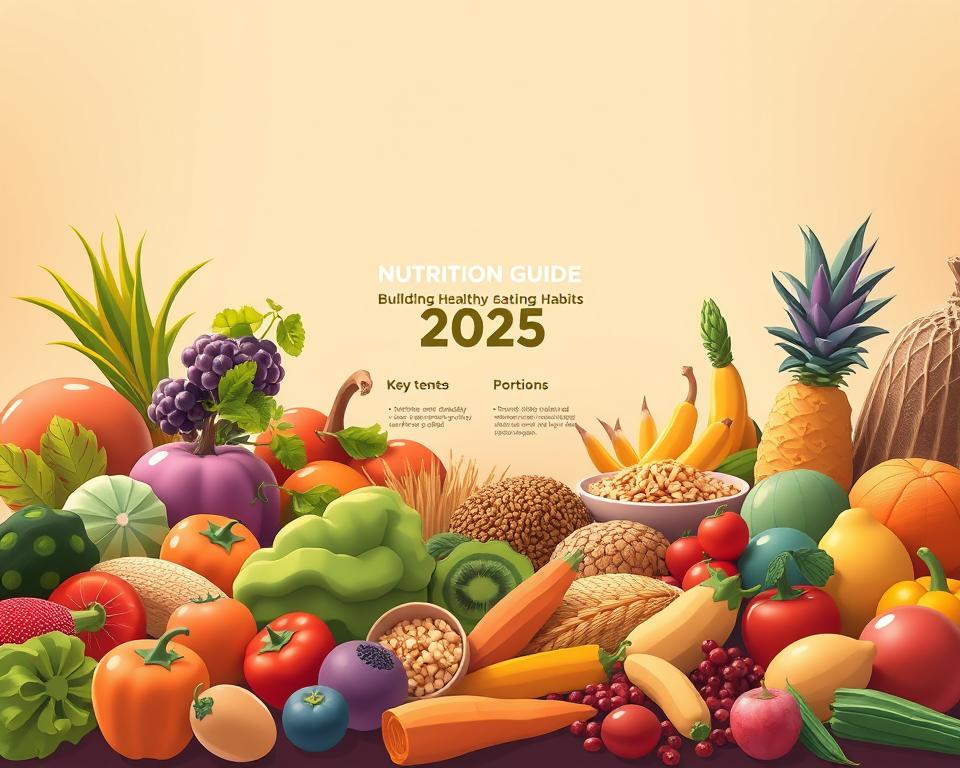Оголошення
How will the food you choose today look different tomorrow?
Nutrition tips matter in 2025 because your daily eating is shaped by culture, new foodtech, and changing systems. People are making decisions with taste, cost, and sustainability in mind. This section sets the scene and explains what to expect.
Food technology now brings clearer labels and smarter kitchen tools that help you cook with skill and save time. You’ll see simple ways to use the Healthy Eating Plate idea to build a balanced meal and enjoy the practical health benefits without rigid rules.
Later, this list shows how fats, sugar, and ultra-processed items have shifted and gives down-to-earth choices for snacks, proteins, and drinks. You’ll find ideas for real foods that fit your day і твій way of eating. For personal health questions, talk with a registered dietitian or qualified clinician.
Why 2025 looks different: culture, foodtech, and your plate today
Labels, apps, and smarter kitchen gear are changing how you shop and cook today.
Оголошення
You now see clearer ingredient lists and on-pack cues that help you pick a preferred source and compare the amount of added sugars or refined oils at a glance. Scan-and-compare apps make it simple to build a grocery list that matches your values.
Stores offer a wider variety of ready-to-cook basics — frozen vegetables, whole grains, and beans — so you can speed dinner up without a long ingredients list. Meal kits and delivery filters let you sort by nutrition and ingredient preferences, saving planning time.
Smart appliances—air fryers, induction hobs, and steam ovens—help you get good texture with less fuss. For example, you can crisp vegetables without deep frying and batch-cook grains for the week.
Оголошення
Sustainability awareness shows up on shelves too: sourcing details and footprint info appear more often, so you can choose a product that fits your budget and values.
- You’re deciding among more plant-forward foods like whole-grain pastas and legumes.
- You’re spotting low- or no-sugar coffee and tea formats that reduce added sweeteners.
- You’re reading labels to limit sodium and added sugar, and to avoid artificial trans fat.
Tech helps with planning, but culture and taste still steer the final choices on your plate. Use this mix of tools and clear information as a practical guide, not a rigid rule — a simple example is swapping a sugary drink for water or a flavored tea when you want less sweet.
Nutrition tips you can trust in 2025
Small culinary choices add up to big benefits over weeks and months. Use this short, evidence-informed checklist to shape everyday food choices without stress.
- Choose drinks with little or no sugar. Prioritize water, coffee, or tea to keep added sugars low across the day.
- Pick healthy oils and whole fats. Use extra virgin olive oil or canola and avoid artificial trans fats (banned in the U.S.) to support a healthy heart.
- Build balanced plates. Half vegetables and fruits, whole grains, and a healthy protein джерело make a simple pattern you can follow for any meal.
- Add small, regular boosts. A handful of nuts or seeds and oily fish during the week add flavor, texture, and nutrients linked to a lower risk of heart disease.
Cook at home more often—one extra home-cooked meal per day is an easy example that can change how you rely on packaged sauces and sweets.
“Small, consistent changes in what you buy and cook can shape long-term habits.”
Примітка: These are cultural cooking practices and general guidance, not medical directives. For personal questions, consult a registered dietitian.
Build your meals with the Healthy Eating Plate
An easy rule—half the plate produce—helps you get more color, fiber, and satisfaction at each meal. The Healthy Eating Plate is a visual guide: half vegetables and fruits, one quarter whole grains, and one quarter healthy protein.
Half your plate: vegetables and fruits in full color
You’ll fill half your plate with vegetables and fruits, aiming for a variety of colors and cooking styles so meals stay exciting. Roast, steam, or toss raw salads to mix textures and flavors.
Remember: potatoes and French fries don’t count as vegetables on this model because of their effect on blood sugar. Instead, choose leafy greens, broccoli, tomatoes, peppers, carrots, and whole fruit.
- Set aside a quarter for whole grains—brown rice, quinoa, oats, or whole wheat pasta—so grains add fiber and texture without crowding vegetables.
- Use the last quarter for healthy protein: fish, poultry, beans, or a small handful of nuts. Skip processed meats.
- Use olive or canola oil lightly for cooking and dressing. Pour water, coffee, or tea with little or no sugar; limit juice and keep dairy to 1–2 servings per day.
Plate by volume, not weight, and prep vegetables in batches (roast a tray of broccoli and carrots) to speed weeknight meals. Treat this layout as a flexible template you adjust across meals and per day.
Rethinking sugar and ultra-processed foods
Added sugar shows up in more places than you think — especially in ready-to-drink beverages and many packaged snacks.
Start with label literacy. Scan ingredient lists for multiple sugar names or refined oils. That quickly flags ultra-processed items that add calories without much fiber or protein.
Added sugars: smarter swaps for everyday drinks and desserts
Target sugary beverages first since they add lots of empty calories and raise blood sugar without the feeling of a full snack.
- Swap soda or sweet tea for sparkling water with citrus, unsweetened tea, or coffee with a splash of milk.
- Keep sweetened coffee drinks and energy drinks as occasional treats — they can add calories quickly.
- Choose fruit-forward desserts like berries with plain yogurt when you want sweetness more often.
Ultra-processed foods: what to watch on the ingredient list
Look for long ingredient lists, multiple sugar aliases, and refined oils. These clues point to highly processed items such as packaged cookies, snack cakes, and many frozen meals.
Simple upgrades: from packaged snacks to whole-food choices
Small swaps add up. Replace chips or cookies with fruit, nuts, plain yogurt, or stovetop popcorn for texture and lasting satisfaction.
For more on how ultra-processed products affect your patterns, read why to rethink ultra-processed foods.
“Gradual changes to your food choices make new habits stick.”
Fats get a refresh: olive oil, vegetable oils, and the end of trans fats
In the kitchen, the story of fat is shifting toward flavorful oils that support cooking and health.
Choose oils that match the job: keep extra virgin olive for dressings and finishing. Use canola or sunflower for higher-heat cooking so flavors stay clean.
Choose oils wisely
Liquid vegetable oils—canola, corn, safflower, sesame, and sunflower—give you light texture without added saturated fat. Rotate sesame or safflower for stir-fries and roasted veg when you want an aromatic boost.
- Keep two main bottles: extra virgin olive for salads and a neutral oil for sautéing.
- Compare olive styles (robust vs. mild) so dressings don’t overpower delicate greens.
- Store oils away from heat and light to preserve flavor and freshness.
Trans fats are banned in the U.S.—what that means when you shop
Artificial трансжири are harmful and are banned, but labels may still show “0 g trans fat.” Always read the ingredient list and avoid “partially hydrogenated” oils.
Use oils thoughtfully—enough to carry flavor but not so much that they mask ingredients. Research links patterns that include olive oil with a lower risk of heart events and benefits for heart disease risk factors, while keeping claims general.
“Extra virgin olive oil adds peppery depth to vegetables, beans, and fish without heavy saturated fat.”
Whole grains and fiber forward
Make whole grains the easy choice and you’ll notice meals that keep you satisfied with less effort. Choose simple swaps that fit your budget and routine.
You’ll stock staples like oats, brown rice, quinoa, barley, and wheat berries so fiber becomes the default at breakfast and dinner. Look for “100% whole wheat” or “whole grain” as the first ingredient when you buy bread or pasta to keep selections straightforward.

Batch-cook grains, freeze portions, or use a rice cooker to save time. Try overnight oats for no-cook mornings and wheat berries in a salad to add chew and comfort per day without extra fuss.
Simple swaps cut empty calories: use whole-grain crumbs or rolled oats in recipes instead of refined versions. Build grain bowls with roasted vegetables, beans, herbs, and a drizzle of olive oil for flavor and texture.
Pair grains with a protein and healthy oil to steady how fast a meal hits your blood sugar. Start by mixing refined and whole items as you adjust, then increase whole choices as you find favorites.
Power proteins: fish, beans, nuts, and seeds take the lead
Shift toward protein sources that bring variety—fish, beans, nuts, and seeds—so meals stay interesting.
Plan fish about twice a week. Aim for salmon, trout, mackerel, or albacore tuna to add omega-3s, tender texture, and quick dinners you can sear or roast.
Use beans and lentils as a hearty plant-forward protein source. Make bowls with roasted vegetables and a drizzle of olive oil for flavor and balance.
Snack on a small handful of nuts or sprinkle seeds over salads, oatmeal, or yogurt for crunch without counting calories. Choose unsalted or lightly salted options when possible.
- You’ll plan fish twice a week—salmon, trout, mackerel, or albacore tuna—for variety and fast cooks.
- You’ll build protein bowls with beans or lentils plus roasted veg and olive oil for a satisfying plate.
- You’ll use nuts and seeds as pestos, toppings, or quick snacks, keeping fat quality in mind.
- You’ll keep portions intuitive: about a quarter of the plate as protein джерело, paired with colorful produce.
“Rotate proteins to find textures your household likes, and use spices like cumin or turmeric to lift simple dishes.”
Some research links patterns rich in fish and plant proteins with a lower risk of heart disease, presented here as general information to guide choices.
Vegetables and fruits, every day, every color
You’ll find that mixing fresh, frozen, and canned produce keeps meals bright and affordable. Aim for color and simple label cues so you spend less time guessing and more time eating well.
Fresh, frozen, or canned: how to choose well at any budget
Shop fresh when prices and seasonality make flavors pop. Use local sales to buy what’s ripe and freeze extras for later.
Lean on frozen when you want low prep and long shelf life. Choose plain bags without sauces so you control seasoning and fat on the stovetop.
Pick canned items labeled no-salt-added or reduced-sodium, and fruit packed in water or its own juice to limit added sugar.
- Mix raw salads with roasted or sautéed sides to vary texture and keep meals interesting.
- Plan produce by color—deep greens, reds, oranges, and purples—to get natural variety without a checklist.
- Size portions by appetite and plate balance rather than strict rules; make vegetables and fruit the easy default.
“Keep cut-up vegetables at eye level so the quickest choice is the healthiest one.”
Better beverages: water up, sugary drinks down
What you sip shapes daily energy and how much sugar or calories you add without meaning to. Make plain water the easy, everyday choice and use simple swaps so you don’t feel deprived.
Hydration basics: water, coffee, and tea with little or no sugar
Choose water, coffee, or tea with little or no sugar to keep added sugars low. Pay attention to sweet creamers and flavored syrups — the amount of calories can climb quickly.
What about juice and dairy? Keep servings in check
Limit juice to a small glass per day and keep milk or dairy to about 1–2 servings per day as part of your plate balance. These choices add nutrients but also add sugar or calories when portions grow.
Sparkling ideas: flavor water with fruit, herbs, and ice
For fizz without sweetness, try sparkling water with citrus, berries, or mint. Brew iced tea at home and sweeten lightly if you must. Cap fancy coffee drinks as treats—many have more sugar than dessert.
- Make water your go-to beverage and carry a refillable bottle as a reminder.
- Save sugar-sweetened options—sodas or energy-style mixtures—for rare occasions; they drive most added sugars in the average day.
- Align beverages with meals—water with lunch, herbal tea after dinner—to make the routine effortless.
For a quick primer on healthy beverage choices, see the healthy drink guide for practical ideas to hydrate well and protect heart health.
“Small swaps in what you sip cut empty calories and help steady appetite.”
Home cooking, labels, and portion awareness
Cooking at home gives you clear control over what goes on your plate and how much you serve. You’ll notice meals become more balanced when you pick your own ingredients and portions.
Read the Nutrition Facts panel to compare sodium, added sugar, and saturated fat. Scan the ingredient list and favor shorter, familiar lists so you keep recipes simple.
Pack lunch with whole-grain bread, low-sodium canned fish or a light egg salad, lots of vegetables, and a piece of fruit. These practical food choices cut surprise calories and make midday meals satisfying.
- You’ll plate by using smaller dishes or pre-plating to avoid grazing from large containers.
- You’ll choose roasting, baking, grilling, or steaming to build flavor without deep frying.
- You’ll keep a bottle of good olive oil and a jar of spice blends on the counter for quick flavor boosts.
Batch-cook grains and proteins, write a short weekly plan, and make a grocery list. These steps reduce last-minute takeout and help you make steady, simple choices that fit your week.
“Small shifts in how you cook and plate change your daily food patterns.”
Lifestyle links: sleep, movement, and mindful routines
When you pair steady movement with better sleep and little mindful pauses, the rest of your food routine falls into place.
Set simple habits that support your plate. Aim for at least 150 minutes of moderate activity each week and add resistance work twice weekly. Move in ways you enjoy so activity fits your schedule.
Make a bedtime routine: dim lights, cut screen time, and wind down so appetite hormones stay steadier the next day. Prep a simple breakfast the night before to smooth busy mornings.
- You’ll treat meals as mindful breaks—slow down and notice flavor and fullness.
- You’ll keep easy snacks (fruit, nuts, cut vegetables) handy for busy moments.
- You’ll invite friends or family to cook and eat together to reinforce habits.
- You’ll set visible cues—water bottle or shoes by the door—to make the next step obvious.
Use a short check-in each evening—what went well, what to shift tomorrow—as a low-pressure way to iterate. Many large studies show routines that include rest and movement are associated with a lower risk dying from several causes, presented here as general information.
“Small, steady routines change the way you plan, shop, and enjoy meals.”
These cultural practices help your heart and make eating feel manageable, not strict. Give yourself permission to adjust—consistency grows from flexibility and patience.
Висновок
,Think of eating as a series of small, repeatable choices that make meals more satisfying and less stressful.
The Healthy Eating Plate is a flexible pattern: half vegetables and fruits, a quarter whole grains, and a quarter protein. Use olive oil to carry flavor, rotate fish and plant proteins, and add nuts or seeds for texture.
Keep beverages simple and watch added sugar in drinks and desserts. Read labels, cook at home when you can, and pick familiar foods—beans, grains, corn, and canned or frozen produce—to fit your culture and budget.
You’ll find these patterns linked in research with a lower risk of heart disease, presented here as general information. For tailored guidance, consult a registered dietitian or your healthcare professional and enjoy exploring food culture in your way.



